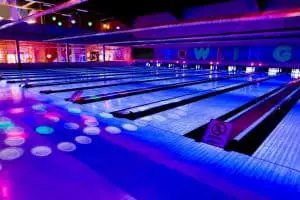 Spending time with your friends and family at a bowling alley might be the most fun thing to do. You get to enjoy bowling yourself while watching your loved ones have a blast at the same time.
Spending time with your friends and family at a bowling alley might be the most fun thing to do. You get to enjoy bowling yourself while watching your loved ones have a blast at the same time.
Everyone wants to be the very best when bowling. It is almost as if your entire reputation is at stake! One wrong throw and there comes the boos flooding in from every direction. So it doesn’t hurt to know a bit about bowling at first, does it?
But no, only learning about bowling will not ensure that your name stays at the top of the scoreboard. You will also be required to have a brief knowledge regarding the lanes you will be playing on.
We are sure you know that lanes can be either really slippery or super dry, but did you know that they can be completely wooden or synthetic too? In fact, the built of the lane will greatly affect your bowling styles! Wood lane was popular before. When the synthetic lane was discovered, all professional bowlers cordially accepted synthetic lanes because synthetic lanes are far better for bowling.
In order to make sure you always have a basic idea regarding the bowling lane, we are going to quickly discuss the differences between wood lanes and synthetic lanes in this article today.
So without further ado, let us get started right away!
Which are Wood Bowling Lanes?
Even though wood lanes and synthetic lanes look super similar, they are actually poles apart.
Wooden lanes are the most common type of lanes found in bowling alleys. These lanes are actually not made of only wood, as they come coated with a layer of either plastic or urethane film.
Wood lanes are known to consist of a really soft surface, hence they actually require more maintenance in the long run. Wood lanes are also known to be slightly rougher than synthetic ones, hence this kind of a lane is best for low rev players who wish for a lower hook potential while playing.
But you have to keep in mind that the risk of splitting is higher when dealing with wooden lanes, as the bowling ball can easily damage the lane due to the throw and weight of the ball. Hence, the lane might even develop several holes or dents, which in turn might affect the bowling style of a player. Sometimes, these dents also change up the entire pattern of a bowler.
What type of wood are bowling lanes made of?
If a lane is made of wood, the type of wood it’s made of will vary depending on where it’s located. Wood lanes in the US and Canada are typically made of maple, while lanes in Europe and Australia are usually made from birch. The most common wood used to make bowling lanes is maple. The reason that maple is used is because it imparts a very smooth surface and it’s also very durable.
Which are Synthetic Bowling Lanes?
Synthetic lanes were first introduced around the 1990’s, after people started to complain about the roughness of wood lanes. On top of that, maintenance of wood lanes was starting to become an issue, as wooden lanes tend to wear out quicker.
Hence, synthetic surfaces were introduced, and people started rejoicing due to the increased longevity of the lanes and low maintenance requirements.
Friction and ball reactions can be influenced greatly by the type of lane in use. Surface texture vary depending on materials and maintenance. Unlike wood lanes, synthetic lanes are actually much harder. Therefore, the amount of friction created between a bowling ball and a synthetic lane is dramatically minimal.
However, synthetic surfaces are much smoother than wooden ones, hence they do stay in good shape for longer and do not need as much as maintenance as wood ones. On top of that, once synthetic lanes are oiled, they tend to stay slippery for longer, unlike wooden lanes which dry out faster. Therefore you get more hook potential on synthetic lanes.
That does not mean you will not get hook potential on wood lanes at all. However, the high hook potential is only visible if you play on a wood lane right after it has been oiled. Or else, the lane will dry out soon after, and you will be welcomed with yet another dry lane.
Differences between Wood Lanes and Synthetic Lanes
It is quite easy to differentiate between wood and synthetic lanes as they come with really distinct features.
One of the easiest ways to differentiate between the two lanes is by noticing the texture of it. Wood lanes tend to be much softer and rougher, whereas synthetic lanes are harder and smoother. There is also a decreased chance of holes developing on synthetic lanes as they do not dry out as fast as wood lanes.
Synthetic lanes also require reduced numbers of maintenance checks since they tend to hold on to the oil for a long time. However, due to the rough texture of wooden lanes, they soak in the oil much faster and dry out soon after. This makes them prone to premature wear and tear as well as holes and dents.
Most of the bowling centers now use synthetic lanes.
The holes and dents can even alter the trajectory of a bowling ball. However, low rev players will like playing on wood bowling lanes as they offer a lower hook potential.
However, if you want to implement the cranker style and go for a higher hook potential, then we suggest you opt for bowling alleys with synthetic lanes as they are much smoother and sleeker to play on. Just make sure to put on high-quality bowling shoes with enough friction first, or you might slip and injure yourself!
How to Choose Your Bowling Ball According to Lane?
Choosing the right bowling ball for a specific bowling lane is not hard at all. In simple terms, if you prefer implementing the stroker style and achieving a lower hook potential, then you should go for bowling balls with a cover-stock and roll with it on a wood lane. The roughness of the wood lane will ensure you get that lower hook potential while the solid cover-stock balances out the speed required in reaching that hook potential.
On the other hand, if you want to go for a higher hook potential with a cranker or tweener style alongside a high ball speed, then we suggest you get yourself asymmetrical bowling ball and check out playing on a synthetic lane.
Conclusion
Regardless of what style you play in, both bowling lane types are amazing in their own rights and offer the best experience for different styled players. We hope you find your specific style and practice playing on the lane that favors your skills better. Thanks for staying with us till the very end.

